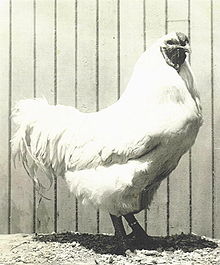Chantecler (chicken)

A White Chantecler rooster at the Abbey of Notre-Dame du Lac in 1926; today's Chanteclers have much smaller wattles
|
|
| Conservation status | critical |
|---|---|
| Country of origin | Canada |
| Use | dual-purpose breed |
| Traits | |
| Weight |
|
| Skin color | yellow |
| Egg color | brown |
| Comb type | cushion |
| Classification | |
| APA | American |
|
|
The Chantecler is a breed of chicken originating in Canada. The Chantecler was developed in the early 20th century, at the Abbey of Notre-Dame du Lac in Oka, Quebec. It is extremely cold-resistant, and is suitable for both egg and meat production.
At the dawn of the 20th century, no breeds of chicken had been established in Canada, and Canadian farmers and poultry fanciers only had fowl of European and American derivation. This fact was noted by Brother Wilfrid Châtelain, a Trappist monk and Doctor of Agronomy, as he toured the poultry flocks of the Oka Agricultural Institute, an agricultural school at his abbey which is affiliated with the Université de Montréal.
In 1907, the Brother set out to remedy this void and create a practical chicken that would be suited to Canada's climate and production needs. Working at the Abbey of Notre-Dame du Lac in Oka, Chantelain first combined Dark Cornishes, White Leghorns, Rhode Island Reds, White Plymouth Rocks and White Wyandottes, creating the White variant of the Chantecler. It was admitted into the American Poultry Association's Standard of Perfection in 1921. By 1918, the breed was presented to the public. To this day, the Chantecler is one of only two breeds of poultry from Canada, and the only one known to have been created primarily by a member of a monastic order.
...
Wikipedia
